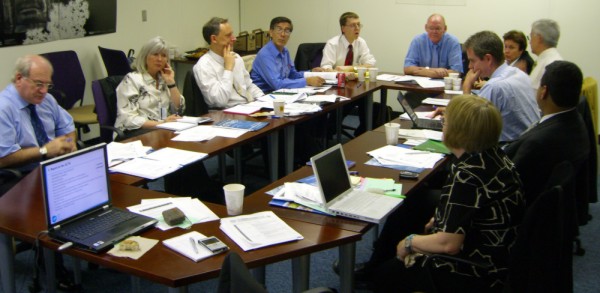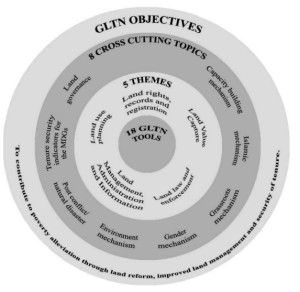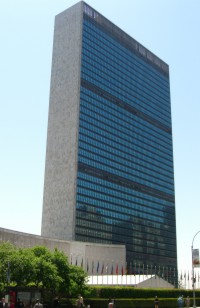Improving the FIG/UN-HABITAT cooperation:
FIG President Stig Enemark attends the GLTN International Advisory Board
Meeting, during the 16th Session of the UN Commission on Sustainable
Development
UN Headquarters, New York, 6-8 May 2008
|

GLTN Advisory Board Meeting, UN-HABITAT Office, New York, 7 May
2008. |
FIG President Stig Enemark attended the Global Land Tool Network
International Advisory Board (IAB) Meeting in New York 7 May 2008 during the
16th Meeting of the UN Commission for Sustainable Development (CSD-16) 5-16
May 2008.
The Global Land Tool Network (GLTN) under UN-HABITAT was launched in June
2006. The main objective is to contribute to the poverty alleviation and the
Millennium Development Goals through land reform, improved land management,
and security of tenure. The GLTN aims to establish a continuum of land
rights rather than just focus on individual land titling. The official
website is available at: www.GLTN.net.
To reach this overall goal the GLTN partners have identified l8 key land
tools that are grouped into 5 overarching themes. Furthermore 8 cross
cutting issues are identified, including gender and grassroots mechanisms.
The themes and issues are available at:
http://www.gltn.net/index.php?option=com_content&task=view&id=11&Itemid=34.
See also the diagram below showing the relation between the GLTN objective,
cross cutting issues, themes and tools.

Diagram showing how the GLTN objective, cross cutting
issues, themes and tools relate.
The GLTN International Advisory Board (IAB) is established to provide
objective advice on issues related to the GLTN policies, operational
strategies and projects. IAB consist of representatives of the various 7
segments of GLTN partners, where FIG represents the international
professional bodies. The full advisory board is available at:
www.gltn.net/index.php?option=com_content&task=view&id=18&Itemid=63.
The meeting in New York was the second of IAB while the first was held in
during the 21st Session of the Governing Council of the United Nations Human
Settlements Programme UN-HABITAT in Nairobi 16-20 April 2007, see:
www.fig.net/news/news_2007/nairobi_habitat_gc_04_2007.htm
The meeting in New York was chaired by the FIG President Stig Enemark due
to apologies from the IAB Chairperson, Mrs. Ambassador Agnes Kalibbala,
Uganda. The key issues included an evaluation of the overall GLTN activities
during the last year. In general GLTN has been very successful in setting a
global agenda focusing on the land tool and land tenure issues. The support
from the GLTN partners is very committed and the interaction between the
grassroots organisations and the international professional bodies appears
as very promising. It should be made clear, however, that GLTN is about tool
development, documentation and assessment while implementation at scale
should be the responsibility of governments. There might be a need for a
business plan on how to work with partners at country level. It should also
be shown that land tools are not only about professionals but can be
delivered by grassroots too.
The GLTN secretariat is headed by Ulrik Westman from the Land,
Tenure and Property Administration Section, UN-HABITAT, Nairobi. The meeting
was also attended by Clarissa Augustinus, Head of this section, Mohamed el Sioufi, UN-HABITAT Shelter Branch; and
Klaus Deininger
from the World Bank Land Thematic Group. Other participants included Chris Paresi (International Institute for Geoinformation Science, ITC),
Jan Peterson (Huairou Commission), Mikael Atterhög, (Swedish
SIDA), Mikael Taylor (Internatonal Land Coalation, ILC), Mona
Brother (Norwegian Ministry of Foreign Affairs), and Siraj Sait
(University of East London, UEL).
As mentioned, the meeting was held during the CSD-16 that is huge UN
event over two full weeks. Interestingly, this was the first time that the
land issue was brought to the very top of the agenda on Sustainable
Development. A whole range of sessions were held to discuss this issue with
a main focus, however, on rural development, agriculture, and natural
resource management. Relevant material of the CSD-16 event is available at:
www.un.org/esa/sustdev/csd/review.htm
During the CSD-16 a range of side-events took place. One of these
organised by UN-HABITAT, related to Gender and Land and included a
presentation from Dr. Diane Dumashie, Chair of FIG Commission 8
entitled "Gendering Land Tools: from Policy to Practice" and showing the
results of the UN-HABITAT/FIG workshop held in Bogamoya, Tanzania, March
2008 on Land Tools: Developing Criteria for Gender Sensitivity. The
presentation is available
here.
UN-HABITAT also hosted a reception Tuesday 6 May that included launching
of a new publication entitled: “Secure Land Rights for All”. The publication
is available at:
http://www.gltn.net/index.php?option=com_content&task=view&id=121&Itemid=17
Read more:
|

Manhattan, New York |

UN Headquarters, New York |

Times Square, Nwe York |
|



























